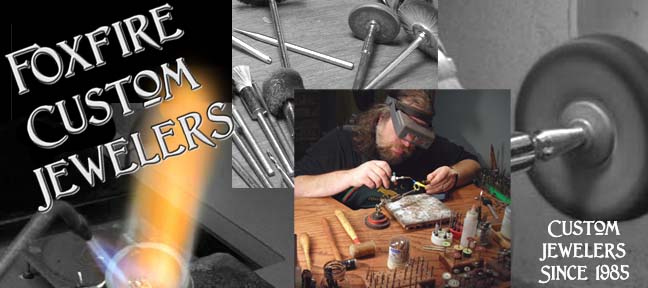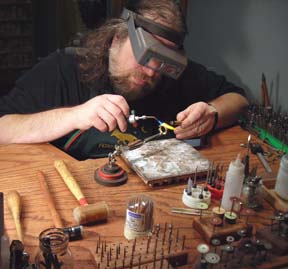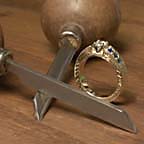
Studio Tour: Real Custom Design Jewelry
Our jewelry artists work with you to create custom jewelry that is highly personal, finely crafted, and of the highest quality. Not just an altered mass market mounting, but real custom jewelry design from start to finish.
Over the years we've made many thousands of custom rings, custom pendants, custom earrings, for our custom design clients, each one different and unique. This is jewelry at it's very best.
Most Jewelers sell jewelry that is mass produced by the thousands in a factory setting, the same design, over and over. Some alter this factory made jewelry and call it custom.
Real custom design jewelry is so much more than simply fitting a setting to an existing mass produced ring or such. It is creating an entirely new piece of jewelry from design to modeling, to casting, fabrication and finishing. It is what Foxfire specializes in.
The biggest thing which distinguishes us from
other custom jewelers is the variety of our designs, and the
care we take with each client. If you have seen our portfolio, you know
how much variety we can create. To see how this custom jewelry is made,
follow the story below.
DESIGN
Sometimes a product of our imagination and
inspiration, or often the result of a custom design consultation with a
client, our designs are unfailingly creative and truly different. If
our client is in store, we can design while they watch, suggest,
comment. Over the web, we will get a good idea of what is wanted, then
email a design drawing.
We can usually find an idea for a client, based on
a series of questions and our intuition. It's amazing to capture just
what someone wants, sometimes immediately, sometimes through a series
of drawings. Sometimes our clients come to us with an idea of exactly
what they want, and it's our job to help them translate that into a
viable piece of jewelry. We welcome your drawings, no matter
how basic, they will always help us to figure out what you are
looking for.
Our customers often express their delight to have
something made which is truly, just what they want, finally.
MODELING
For many pieces we use a process called Lost Wax Casting, and the first
step is to carve a wax model of the ring, pendant or other jewelry
creation. There are several techniques we use to achieve the best
possible wax model:
CAD/CAM (Computer Assisted Design/ Computer Assisted Modeling)
This is where we use a special computer program
(and a bit of skill) to create a 3 dimensional design for the jewelry
piece. We can then make a photo realistic rendering of what the jewelry
will look like. We then email these pictures for your approval. Once
this is done we use a computer guided mill to carve the wax model to
exacting precision. Our milling process uses a special technique to
achieve smoother results than are commonly available.
HAND CARVING
Some designs are just not meant to be done
by CAD/CAM. Organic, curvy, nonlinear designs will often want to be
hand carved.
We use several different hardnesses of wax, from
soft candle-like wax to wax resembling hard plastic. From these we
fashion an exact likeness of what the article will be, using files,
scrapers, rotary tools and sharp carving blades to shape the wax.
Often, we will build up the wax by melting with a wax pen, other times
filing and removal are the preferred method.
GETTING IT RIGHT
We can email a series of photos of the wax model,
or in some cases, send the wax directly to you to handle and view.
After any alterations, we will again show you to make sure the wax meets your approval, then it's on to casting.
CASTING
The completed wax model is encased in a special
plaster investment which will withstand very high temperatures. After
hardening then take the plaster mold, and put it in the kiln (a high
temperature oven) where over the course of several hours it is heated
to 1,500 degrees, so that the wax vaporizes leaving no residue.
Then it is time to cast. After stabilizing the
flask at its casting temperature, it's placed on the vacuum machine in
position so that vacuum pressure is drawn through the porous plaster.
At the same time we will have melted the appropriate amount of Karat
gold casting grain (like little BB's of gold) in the crucible, which we
heat with a large torch. With the flask under vacuum pressure, we then
cast the ring by quickly pouring the molten gold into the flask where
it immediately solidifies.
We then dunk the flask in cold water where the remaining heat causes
the plaster to boil away and dissolve almost explosively. Then we can
wash off any remaining plaster from the ring and begin the next step.
We take a lot of pride in our casting abilities. Through careful monitoring of temperatures and alloys, we are able to achieve superior results, yeilding finished pieces that are dense and free from pits and voids.
FINISHING
After casting, the jewelry piece has the general
shape and form of the final product but has a rough surface texture.
This is a critical area because it not only determines the shine, but
has a big effect on the quality of the jewelry.
First we smooth the contours of the piece using the files, both coarse
and fine, then sandpaper and various rotary tools to take any roughness
away. This is a very important step for any variations here will affect
the final shape of the creation, and our artists are experts at shaping
and smoothing the design without losing any detail.
Then the article progresses to polishing. Using
felt and cloth wheels on the polishing motor, and on handheld rotary
tools, the surface of the jewelry is refined to a high shine, first
with Tripoli, then finally polishing with Rouge. We often polish in
areas that go untouched by mass producers.
Have you ever seen a jeweler pick up a piece of
jewelry to look at it? Almost immediately they will turn it over and
look at the back, or underneath, because it's these hidden details that
say everything about the skill and dedication of the maker. We aim to
impress the consumer and professional alike.
 This is
the oldest
technique in our repertoire, the art of building a piece of jewelry by
forming sheet and wire, and using them to assemble the jewelry. This
technique comes down to us from the Ancient Egyptians, who used it to
create stunning treasures long before casting was invented.
This is
the oldest
technique in our repertoire, the art of building a piece of jewelry by
forming sheet and wire, and using them to assemble the jewelry. This
technique comes down to us from the Ancient Egyptians, who used it to
create stunning treasures long before casting was invented.
Some pieces are produced entirely by fabrication, that is, forming
parts from sheet and wire and putting them together with gold solder.
Other times we will add some details to a cast piece; such as prongs
and bezel settings, and other design elements.
Gold solder is unlike what most people picture when the word solder is
used, for it contains no lead or other soft metals. Instead, the 14
Karat Plumb Gold Solder (and 18 Karat, Platinum, etc are plumb
as well) we use is actually 14 Karat gold. As we know 14 Karat gold is
14 parts pure gold and 10 parts alloy. In gold solder the 10 parts
alloy are formulated to make the solder melt at a slightly lower
temperature than regular 14 Karat gold.
We use only plumb solder at Foxfire Jewelers,
instead of the standard repair solders many jewelers use which can be
up to a half karat below the marked quality.
STONE SETTING
From what you have read so far, you know we're
picky, dedicated, and well, jewelry nerds. Stone setting is no
different. We usually work under one of our microscopes which use
special designed mountings to attach right to our jewelry benches. We
carefully seat and set stones, using the best techniques and assisted
by our Gravermach pneumatic assist tools, sharp burs, gravers, and hand
tools. We make sure there is enough metal holding the stones in place
to ensure a quality piece of jewelry. Some setting choices include:
Prong Setting
Bezel Setting
Channel Setting
Pave' setting
Bar setting
ADVANCED TECHNIQUES

Some of our pieces, particularly rings, feature
hand engraving, a time honored and precise technique. Using carefully
sharpened chisel-like tools called gravers, the goldsmith carves
intricate designs directly into the metal itself, always using our
specially designed microscope for precision. For this we layout the
design, an art in itself, then carve the metal with the assist of our
Gravermach for added control and detail.
This is most often used to give the piece a vintage, Victorian appearance. When combined with handmade fabricated filigree, the look is very striking.
 Pave setting is a setting
technique which uses those same gravers to form prongs to hold stones
in place. Starting with a plain surface, the goldsmith carves and forms
beads around the stones after placing them in precisely drilled seats.
Then gravers are again employed to carve a bright border around the
stones, completing the setting.
Pave setting is a setting
technique which uses those same gravers to form prongs to hold stones
in place. Starting with a plain surface, the goldsmith carves and forms
beads around the stones after placing them in precisely drilled seats.
Then gravers are again employed to carve a bright border around the
stones, completing the setting.
YOUR FINISHED MASTERPIECE